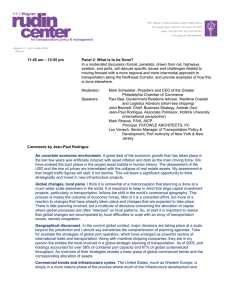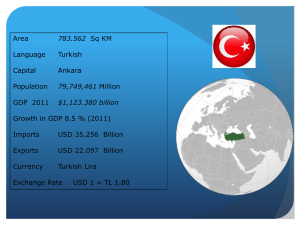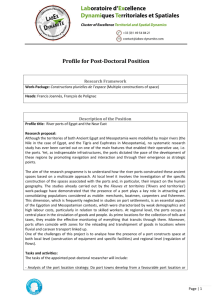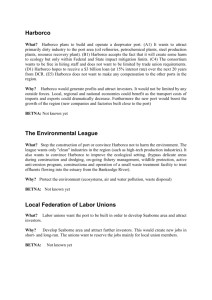Notes from Feb 19, 2014 “Toolkit Brainstorming Session”, San Diego
advertisement
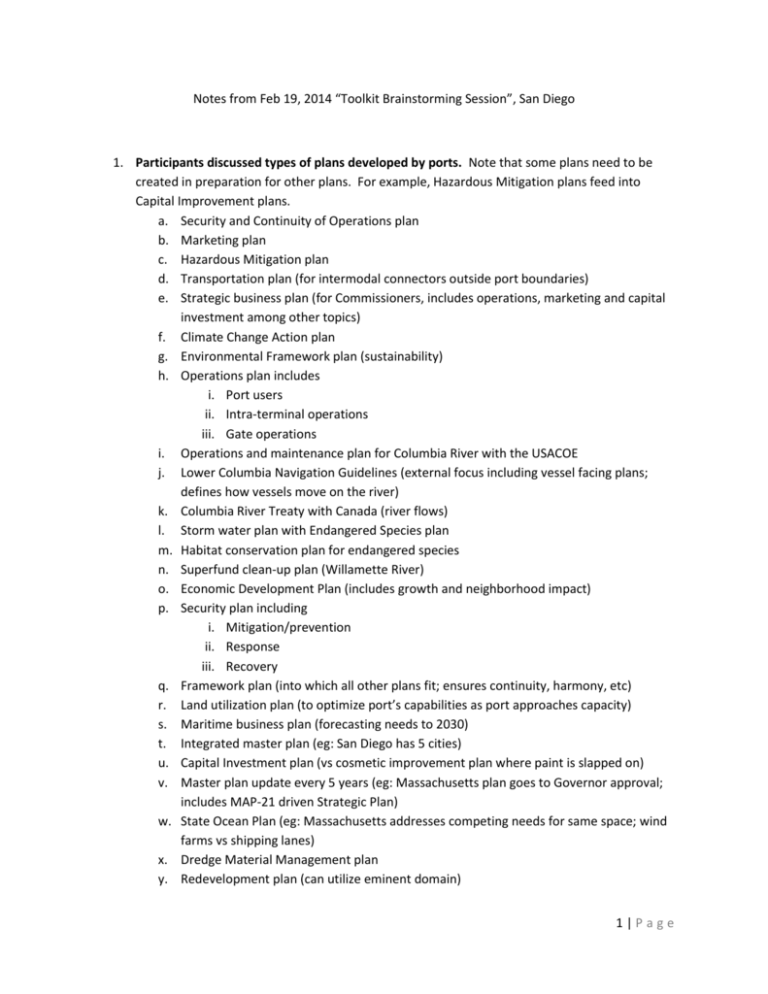
Notes from Feb 19, 2014 “Toolkit Brainstorming Session”, San Diego 1. Participants discussed types of plans developed by ports. Note that some plans need to be created in preparation for other plans. For example, Hazardous Mitigation plans feed into Capital Improvement plans. a. Security and Continuity of Operations plan b. Marketing plan c. Hazardous Mitigation plan d. Transportation plan (for intermodal connectors outside port boundaries) e. Strategic business plan (for Commissioners, includes operations, marketing and capital investment among other topics) f. Climate Change Action plan g. Environmental Framework plan (sustainability) h. Operations plan includes i. Port users ii. Intra-terminal operations iii. Gate operations i. Operations and maintenance plan for Columbia River with the USACOE j. Lower Columbia Navigation Guidelines (external focus including vessel facing plans; defines how vessels move on the river) k. Columbia River Treaty with Canada (river flows) l. Storm water plan with Endangered Species plan m. Habitat conservation plan for endangered species n. Superfund clean-up plan (Willamette River) o. Economic Development Plan (includes growth and neighborhood impact) p. Security plan including i. Mitigation/prevention ii. Response iii. Recovery q. Framework plan (into which all other plans fit; ensures continuity, harmony, etc) r. Land utilization plan (to optimize port’s capabilities as port approaches capacity) s. Maritime business plan (forecasting needs to 2030) t. Integrated master plan (eg: San Diego has 5 cities) u. Capital Investment plan (vs cosmetic improvement plan where paint is slapped on) v. Master plan update every 5 years (eg: Massachusetts plan goes to Governor approval; includes MAP-21 driven Strategic Plan) w. State Ocean Plan (eg: Massachusetts addresses competing needs for same space; wind farms vs shipping lanes) x. Dredge Material Management plan y. Redevelopment plan (can utilize eminent domain) 1|Page z. Regional plans (include economic development, freight and environmental plans) aa. Comprehensive truck management plan (eg: Oakland; CARB requires new engines) bb. Economic Impact Studies and Environmental Impact Studies (address funding needs; evaluating and costing projects) cc. Financial plan dd. Communication plan (including crisis management) ee. Multi-state corridor development plan ff. Business continuity credentialing plan gg. Mitigation plan hh. Alternative fuels facility plans 1. NOTES i. Consider subdocuments for departments with focus for that office and an overall summary of Master Plan and how it fits into that ii. NY/NJ prepares (this is a partial listing) a. Annually - Enterprise risk management plan b. 3 years – Clean Air plan c. 5 years – Land Use plan d. 20 years – strategic plan & regional good movement (Map-21) iii. All documents in the Toolkit need to be functional iv. Master Plan goals reflected in annual performance evaluations for senior management 2. Participants each named one or more topics they would like to see included within the Toolkit a. Performance metrics b. Risk planning c. Bathymetry d. Return on Investment (what are inputs, outputs and expected outcomes) e. Benefit Cost Analysis (what are inputs, outputs and expected outcomes) f. Evaluation of funding sources (PROS/CONS; include federal state local and private) g. National Export Initiative Tools for ports (Department of Commerce) h. What other tools are already available from federal sources – reference those i. Primary Freight Network/National Freight Plan j. Economic impact analysis (Net Present Value) k. Navigational aids and dredging plans (including mitigation and sounding of channels) l. NEPA for dummies m. Enterprise valuation/Private investment (valuing port land is different than property appraisal) n. Project Management Tools o. Market trends (link to usage of resources) p. Grant lessons learned and best practices w/tickler sheet for ports to reference q. Funding 101 r. Planning 101 2|Page s. t. u. v. w. x. y. z. aa. Development of SWOT analysis for infrastructure projects Communicating project (includes demand forecast and needs) Quantifying risk Supply chain calibration (dock/gate/intermodal connection capacity and capabilities need to be harmonized) How to predict demand for projects Public/private partnerships with existing tenants Regional plans (who to include; MPO/State DOT/community) Define success for YOUR port Scenario planning (how to develop a plan; include process) 3|Page
